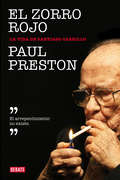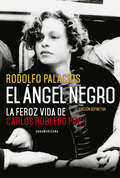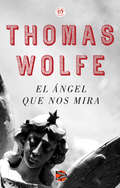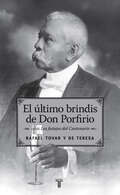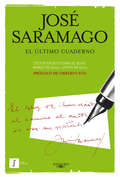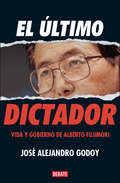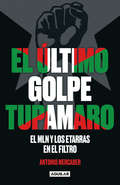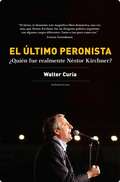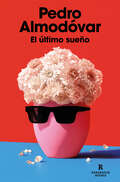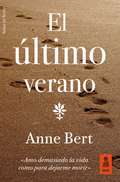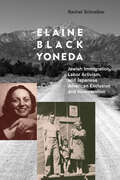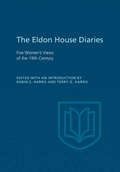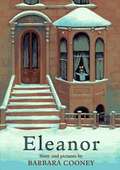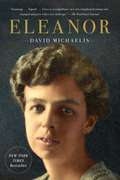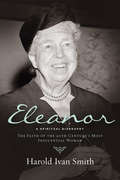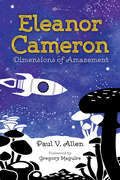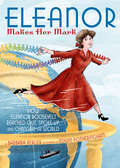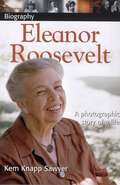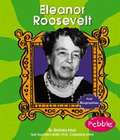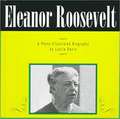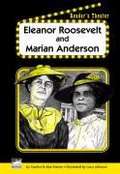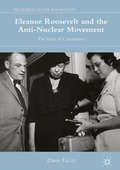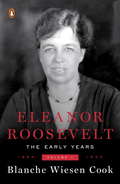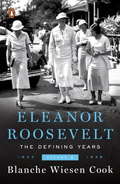- Table View
- List View
El zorro rojo: La vida de Santiago Carrillo
by Paul PrestonLa biografía del líder comunista español Santiago Carrillo, figura fundamental del siglo XX El fallecimiento de Santiago Carrillo el 28 de octubre de 2012 puso fin a noventa y siete años vividos intensamente y en primera fila de la política. Hijo de Wenceslao Carrillo, dirigente socialista, su primer recuerdo era visitar a su padre en prisión. Aún adolescente participó en la huelga de 1934 y pasó por la cárcel, donde se radicalizó. Tras un viaje a Moscú logró unificar las juventudes del PSOE y del PCE en vísperas de la Guerra Civil, para a continuación unirse a los comunistas. Durante la guerra ocurrió uno de los episodios más oscuros de su vida, la matanza de presos rebeldes en Paracuellos, cuando era responsable de seguridad en Madrid. Tras la guerra permaneció treinta y ocho años exiliado, siempre en la dirección comunista, que ejerció con mano de hierro. Su giro hacia el eurocomunismo y su papel fundamental en la Transición aliviaron su figura. Paul Preston, el historiador más importante del siglo XX español, autor de las biografías definitivas de Franco y de Juan Carlos I, dedica su nuevo libro a uno de los personajes más fascinantes e inasibles de la historia reciente de nuestro país. La crítica ha dicho... «...su demoledor y controvertido retrato del principal líder de la oposición antifranquista arrancará sarpullidos.» El País
El ángel negro: La feroz vida de Carlos Robledo Puch
by Rodolfo PalaciosHistoria del mayor homicida múltiple en la historia del país, que a comienzos de la década del 70 y cuando todavía no había cumplido los 20 años conmocionó a la sociedad con el asesinato de 11 personas. «El escriba del hampa, Rodolfo Palacios (RP), el más genuino y autorizado narrador de la historia criminal de la Argentina, reincide en la picardía de caer ante la fascinación delincuencial. Y ofrece, como un entomólogo, a un personaje fascinante como Robledo Puch, el ángel negro.» Andrés Calamaro "Algún día voy a salir y los voy a matar a todos", amenazó Carlos Robledo Puch ante un perito. Entre marzo de 1971 y febrero de 1972, había matado a balazos, por la espalda y mientras dormían a once personas, incluidos sus dos únicos amigos. Su captura -la de un chico bello, de ojos claros y rulos rubios- causó tanto espanto como sorpresa. Con la respiración entrecortada, el país siguió el raid sangriento y vertiginoso de ese criminal inverosímil: el mayor asesino serial de la historia argentina bajo la piel blanca y pecosa de un ángel. Décadas después, Rodolfo Palacios, uno de los mejores narradores del inframundo patibulario, accedió a la intimidad hasta entonces infranqueable de Robledo Puch, la geografía mínima de la prisión donde cumplía condena a cadena perpetua. De esa relación estrecha surge esta biografía ejemplar en la que el autor desnuda el alma torturada de su personaje, pero sin poder evitar el eclipse de la propia. Como él mismo dice, "no hay antídoto contra la oscuridad".
El ángel que nos mira
by Thomas Wolfe José Ferrer AleuWilliam Oliver Gant, cuyos antepasados ??se habían asentado en Pennsylvania, había sido aprendiz de cantero. Se trasladó finalmente al Sur y, después de dos matrimonios, llegó a Altamont, pequeña ciudad de montaña que es el equivalente ficcional del Asheville natal del autor. Allí conoció a Eliza Pentland, que venía de una establecida y excéntrica familia de esa región.Después de un noviazgo formal se casó con ella. Incluso entonces, Gant era un hombre salvaje y exuberante, capaz de borracheras épicas y dueño de una vitalidad indomable. A finales del siglo XIX, con más de 50 años, concibió su último hijo. Con esta introducción extraña y retrospectiva se establecen las circunstancias de los primeros años de Eugene Grant y los eventos de su primera infancia se graban y cuentan extensamente.
El último brindis de Don Porfirio
by Rafael Tovar y de TeresaDel autor de la novela Paraíso es tu memoria, Rafael Tovar y de Teresa.El último brindis de Don Porfirio, ilustrado con más de 150 imágenes, muchas de ellas inéditas, es la crónica del último año de un gobernante que no supo despedirse a tiempo.Hace cien años, Porfirio Díaz se fijó objetivos claros para celebrar el Centenario de la Independencia. Recordar el movimiento libertario no sería lo único sino también mostrar al mundo que sus treinta años en el gobierno -bajo el credo #orden, paz y progreso#- habían transformado al país en una nación estable y respetada con crédito internacional, en pujante progreso y marcada por los aires modernizadores que soplaban en el mundo al iniciar el siglo XX.Más allá de las elegantes fiestas, la celebración dejó huella en más de mil quinientas poblaciones que se beneficiaron de cuando menos una muestra material y tangible de infraestructura con significado cívico e histórico. Se logró que los diversos sectores de la sociedad fueran parte de la conmemoración a la que se sumaron delegaciones extranjeras que dejaron testimonio de su aprecio y respeto por México. Sin embargo, este festejo digno de un gran país no pudo contener lo evidente, pronto estallaría una violenta revolución que mostraría los dos rostros de México: el del inicio del progreso y el de la profunda desigualdad social.
El último cuaderno
by José SaramagoUn bloguero llamado Saramago. Este último cuaderno, con prólogo de Umberto Eco, recoge los textos que el Premio Nobel de Literatura escribió en su blog desde marzo de 2009 hasta junio de 2010, fecha de su última entrada. ES TIEMPO DE VOLVERAL COMPROMISO:EL ESCRITOR TIENE QUE DECIRQUIÉN ES Y QUÉ PIENSA «No es este un libro triste, no es un libro tronante, es, simplemente, una despedida. Por eso, José Saramago, pese a estar atento a la anécdota del día o al suceso terrible, pese a usar el humor y la ironía y emplearse a fondo en la compasión, rescata textos dormidos que son actuales y nos los deja como regalos inesperados, no como un testamento, simplemente ofrendas íntimas que desvelan pasiones y sueños. Nos acerca al mundo de Kafka, o a la inevitable tristeza de Charlot, o nos describe la soberbia aventura de coronar la cima de la Montaña Blanca, en Lanzarote. Este es un libro de vida, un tesoro, un Saramago que nos habla al oído para decirnos que el problema no es la justicia, sino los jueces que la administran en el mundo. No habrá más cuadernos, esa mirada oblicua para ver el revés de las cosas, la frontal, sin bajar nunca la cabeza ante el poder, sí para besar, la ironía, la curiosidad, la sabiduría de quien no habiendo nacido para contar sigue contando, y con qué actualidad ahora que ya no está y tanta falta nos sigue haciendo. Así son las despedidas de los hombres que saben que han nacido de la tierra y que a la tierra vuelven, pero abrazados a ella, con esa especie de inmortalidad que ofrece el suelo del que nos levantamos cada día, con nuevas experiencias incorporadas. Las de quienes son suelo y tierra, nuestro sustento, tal vez nuestra alma.»Pilar del Río
El último dictador
by José Alejandro GodoyLos diez años en que Alberto Fujimori ejerció la presidencia del Perú (1990-2000) constituyen un capítulo crucial para entender nuestra historia contemporánea. Este periodo se ha calificado como el último gobierno autoritario del siglo XX en el país. Así lo entiende el autor de este libro, José Alejandro Godoy, quien, mediante una pormenorizada investigación periodística y bibliográfica, da cuenta de los manejos del poder durante una década de violencia, corrupción y autoritarismo, cuyos efectos pueden rastrearse aún en nuestra época. Más que un análisis político de los años noventa en el Perú, El último dictador está concebido como un exhaustivo relato de los hechos más significativos de la vida y del gobierno de Alberto Fujimori. Un ejercicio de memoria histórica donde los lectores serán quienes saquen sus propios juicios de valor sobre los diez años en que nos extraviamos del camino hacia la democracia.
El último golpe tupamaro: El MLN y los etarras en El Filtro
by Antonio MercaderUn libro polémico, que sin duda despertará opiniones encontradas. Uruguay es el único país en donde cada año se realiza un acto público a favor de la ETA, mientras en otros se hacen manifestaciones masivas de protesta contra sus crímenes. Los manifestantes marchan por bulevar Artigas, desde el Obelisco al ex hospital Filtro, en recuerdo de aquella jornada con una víctima fatal. Este libro indaga en ese episodio de la historia reciente, cuyas consecuencias se hacen sentir hasta hoy, y lo conecta directamente con el accionar tupamaro. A comienzos de los años noventa, quince miembros de la banda llegaron a Uruguay e instalaron un par de restaurantes de comida vasca. A instancias del gobierno español de Felipe González, se pidió la extradición de ocho de ellos. La Justicia uruguaya concedió solo tres, de activistas acusados de homicidios, entre muchos delitos. El proceso judicial insumió dos años, lapso en el cual el Frente Amplio y el PIT-CNT desarrollaron una estentórea campaña para que se negara la extradición. Tres etarras en huelga de hambre –que después se com-probaría no era tal– fueron internados en el hospital Filtro. Grupos de izquierda, en particular los tupamaros, instalaron un campamento para resistir las extradiciones. El expresidente José Mujica y su posterior ministro de Interior, Eduardo Bonomi, fueron quienes convocaron a la marcha. El Movimiento de Liberación Nacional (MLN) convenció al Frente Amplio, y en especial a Tabaré Vázquez, de concurrir a la manifestación. En palabras del exjefe tupamaro Jorge Zabalza, aquel enfretamiento armado sirvió de entrenamiento para “los jóvenes radicales deseosos de tener su bautismo de fuego”. Allí volaron piedras y sonaron disparos, los que motivaron una respuesta policial que dejó como trágico saldo un manifestante muerto y dos docenas de heridos. En este libro, que se publica póstumamente, Antonio Mercader narra los hechos de esa fatídica marcha violenta en plena democracia. Demuestra la relación de los tupamaros con los etarras y cómo se sumaron esfuerzos para atentar contra un fallo judicial y un gobierno democrático. Describe cómo los tupamaros practicaban un doble juego: por una parte, eran un grupo político que postulaba a legisladores para integrar el Parlamento democrático, y por otra, seguían cometiendo delitos. A partir del fracaso del Filtro, “el último golpe tupamaro”, optaron por abandonar la vía criminal que habían iniciado en 1963.
El último peronista: ¿Quién fue realmente Néstor Kirchner?
by Walter CuriaActualización y revisión de la biografía que había sido editada porprimera cuando Kirchner era el presidente de los argentinos. «El texto de Curia lejos está de ser complaciente. Consigue un libroequilibrado: cal y arena, donde deben estar. Certero en la crítica,eficaz en el halago, está escrito por un periodista que ha escuchado yescudriñado en todas las campanas. No hay rabia ni exaltación en estaobra. Solo información, bien escrita y más que recomendable si se quiereconocer más a fondo quién es Néstor Kirchner». Sergio Moreno periodistadel diario Página 12Tras su inesperada muerte, el personaje adquiere toda su dimensión.Colérico, obsesionado por el dinero, con una ambición que lo llevó aimaginar un plan para perpetuarse en el poder durante veinte años,imprudente con su salud a tal punto que Eduardo Duhalde dijo de él quese estaba «inmolando», caprichoso como dicen que le reprochó su viuda,la presidenta Cristina Fernández, acariciando el féretro, Curia afirmaen estas páginas, revisadas y actualizadas, que en sus últimos díasKirchner se atormentaba tratando de imaginar un cambio de escenariopolítico que garantizara la continuidad de su proyecto en las eleccionesde 2011.
El último sueño
by Pedro AlmodóvarEl libro más personal de Pedro Almodóvar: un autorretrato articulado en doce relatos que revelan su pasión secreta por la escritura «Un libro de hallazgos. Que Almodovar era un gran escritor ya lo sabía, sólo hacía falta descubrir desde cuando. De la infancia hasta anteayer, su escritura nos lleva de la mano por un bosque sorprendente. Nacer al revés, (al final), y vivir para atrás es sólo uno de sus talentos. Hay más, avanzar también como un tranvía (de deseo). Al leer estos relatos uno no sabe si ha sido invitado a su cabeza o a su alma. En cualquier caso, es un regalo. Y una dulce intromisión».Ray Loriga «Este libro es lo más parecido a una autobiografía fragmentada. [...] El lector acabará obteniendo la máxima información de mí como cineasta, como fabulador y el modo en que mi vida hace que una cosa y las otras se mezclen». Así define el autor este volumen, en una brillante introducción que sirve también de puesta en perspectiva: los doce relatos que lo componen abarcan varias épocas, desde finales de la década de los sesenta hasta la actualidad, y en ellos se reflejan algunas de sus obsesiones más íntimas, además de su evolución como artista. Los oscuros años escolares, la influencia de la ficción en la vida, los efectos inesperados del azar, la sofisticación del humor, los inconvenientes de la fama, la fascinación por los libros o la experimentación con los géneros narrativos son algunos de los temas que pueblan este libro imprescindible, que contiene múltiples capas de lectura. En librerías el 13 de abril de 2023 La crítica ha dicho...«Tesoro encontrado, objeto de coleccionista, álbum de cromos en el que brillan los destellos del imaginario de un genio».Sabina Urraca «La prosa de Almodóvar es tan hábil e ingeniosa como sus películas. [...] Es, por así decirlo, como un Warhol con chispa y, desde luego, con más vigor».The Times «Un maestro en el arte de contar historias desenfrenadas y atrevidas».Le Quotidien du cinéma«Un aviso para los amantes de los directores de cine que escriben. Esto no es ni Woody Allen ni mucho menos Werner Herzog, sino más bien un William Burroughs con mucho humor: ese es Pedro Almodóvar».Buchkritik - Deutschlandfunk Kultur«Con la humilde e ingeniosa atención de quien mira las pasiones humanas para conjugarlas en la inescrutable lógica de la vida, Almodóvar visita todo el espectro de colores de nuestra alma: el dolor, la tristeza, el cariño, la nostalgia, la euforia, la disforia, el impulso incontenible de comunicar, la frustración del silencio».Antonio Tabucchi
El último verano
by Anne BertAmaba su existencia con pasión, pero estaba condenada, y Anne Bert decidió elegir no sufrir hasta el final la tortura infligida por la esclerosis lateral amiotrófica. Este es el viaje definitivo de la autora. El que la obligó a morir fuera de la ley, prisionera de sí misma, porque la justicia francesa no autorizó acortar su sufrimiento. Una sugerente invitación a descubrir el sabor de los momentos finales; a aprender a pensar en la muerte; a despedirse de los seres que uno quiere, y a enfrentar el reto de las últimas alegrías a pesar del dolor. Una oda a la libertad y a la vida, solo posible por la determinación de esta escritora a eludir el deterioro final. «A la luz de este último verano que saboreo, tan rodeada y, sin embargo, tan solitaria, estos son los fragmentos de este cara a cara con la mortalidad».
Elaine Black Yoneda: Jewish Immigration, Labor Activism, and Japanese American Exclusion and Incarceration
by Rachel SchreiberDuring World War II, Elaine Black Yoneda, the daughter of Russian Jewish immigrants, spent eight months in a concentration camp—not in Europe, but in California. She did this voluntarily and in solidarity, insisting on accompanying her husband, Karl, and their son, Tommy, when they were incarcerated at the Manzanar Relocation Center. Surprisingly, while in the camp, Elaine and Karl publicly supported the United States’ decision to exclude Japanese Americans from the coast. Elaine Black Yoneda is the first critical biography of this pioneering feminist and activist. Rachel Schreiber deftly traces Yoneda’s life as she became invested in radical politics and interracial and interethnic activism. In her work for the International Labor Defense of the Communist Party, Yoneda rose to the rank of vice president. After their incarceration, Elaine and Karl became active in the campaigns to designate Manzanar a federally recognized memorial site, for redress and reparations to Japanese Americans, and in opposition to nuclear weapons. Schreiber illuminates the ways Yoneda’s work challenged dominant discourses and how she reconciled the contradictory political and social forces that shaped both her life and her family’s. Highlighting the dangers of anti-immigrant and anti-Asian xenophobia, Elaine Black Yoneda recounts an extraordinary life.
Eldon House Diaries: Five Women's Views of the 19th Century
by Robin Harris Terry HarrisEldon House is a distinctive element in the historical townscape of London, Ontario. By the mid-nineteenth century, its original owners, John and Amelia Harris, were prominent members of society in that dynamic community. Their children grew up in the affluent and cultured setting of a family whose increasing prosperity advanced with that of London and western Ontario. If London had an elite, the Harris family was part of it, and Eldon House was an important focal point of the social regimen of the day. A considerable corpus of family papers within the Eldon House and prominent among these papers is a collection of diaries that are excerpted in this volume, encapsulating the personalities, activities, and voices of the Harrises of London. These diaries are valuable because of the details of the warp and woof of daily life in the nineteenth century. But, more importantly, they are women's diaries. As such, they speak to us of the verities of personal, domestic, and societal life in the neglected voice of women. Together, they provide a fascinating perspective of these women's lives in, around, and beyond Eldon House.
Eleanor
by Barbara CooneyPresents the childhood of Eleanor Roosevelt, who married a president of the United States and became known as a great humanitarian.
Eleanor
by David MichaelisPrizewinning bestselling author David Michaelis presents a breakthrough portrait of Eleanor Roosevelt, America’s longest-serving First Lady, an avatar of democracy whose ever-expanding agency as diplomat, activist, and humanitarian made her one of the world’s most widely admired and influential women. In the first single-volume cradle-to-grave portrait in six decades, acclaimed biographer David Michaelis delivers a stunning account of Eleanor Roosevelt’s remarkable life of transformation. An orphaned niece of President Theodore Roosevelt, she converted her Gilded Age childhood of denial and secrecy into an irreconcilable marriage with her ambitious fifth cousin Franklin. <P><P>Despite their inability to make each other happy, Franklin Roosevelt transformed Eleanor from a settlement house volunteer on New York’s Lower East Side into a matching partner in New York’s most important power couple in a generation. When Eleanor discovered Franklin’s betrayal with her younger, prettier social secretary, Lucy Mercer, she offered a divorce and vowed to face herself honestly. Here is an Eleanor both more vulnerable and more aggressive, more psychologically aware and sexually adaptable than we knew. She came to accept FDR’s bond with his executive assistant, Missy LeHand; she allowed her children to live their own lives, as she never could; and she explored her sexual attraction to women, among them a star female reporter on FDR’s first presidential campaign, and younger men. Eleanor needed emotional connection. She pursued deeper relationships wherever she could find them. Throughout her life and travels, there was always another person or place she wanted to heal. <P><P>As FDR struggled to recover from polio, Eleanor became a voice for the voiceless, her husband’s proxy in presidential ambition, and then the people’s proxy in the White House. Later, she would be the architect of international human rights and world citizen of the Atomic Age, urging Americans to cope with the anxiety of global annihilation by cultivating a “world mind.” She insisted that we cannot live for ourselves alone but must learn to live together or we will die together. Drawing on new research, Michaelis’s riveting portrait is not just a comprehensive biography of a major American figure, but the story of an American ideal: how our freedom is always a choice. Eleanor rediscovers a model of what is noble and evergreen in the American character, a model we need today more than ever. <P><P><b>A New York Times Bestseller</b>
Eleanor A Spiritual Biography: A Spiritual Biography: The Faith Of The 20th Century's Most Influential Woman
by Harold Ivan SmithMore than fifty years after her death, Eleanor Roosevelt is remembered as a formidable first lady and tireless social activist. Often overlooked, however, is her deep and inclusive spirituality. Her personal faith was shaped by reading the New Testament in her youth, giving her a Jesus-centered spirituality that fueled her commitment to civil rights, women's rights, and the rights of all "little people" marginalized in American society. <P><P>She took seriously Jesus' words and despite her life of privilege, she made the needs of those on the margins her priority. Eleanor: A Spiritual Biography provides insight into one of America's most famous women, particularly the spiritual influences that made her so active in social justice issues.
Eleanor Cameron: Dimensions of Amazement
by Paul V. AllenEleanor Cameron (1912-1996) was an innovative and genre-defying author of children's fiction and children's literature criticism. From her beginnings as a librarian, Cameron went on to become a prominent and respected voice in children's literature, writing one of the most beloved children's science fiction novels of all time, The Wonderful Flight to the Mushroom Planet, and later winning the National Book Award for her time fantasy The Court of the Stone Children.In addition, Eleanor Cameron played an often vocal role in critical debates about children's literature. She was one of the first authors to take up literary criticism of children's novels and published two influential books of criticism, including The Green and Burning Tree. One of Cameron's most notable acts of criticism came in 1973, when she wrote a scathing critique of Roald Dahl's Charlie and the Chocolate Factory. Dahl responded in kind, and the result was a fiery imbroglio within the pages of the Horn Book Magazine. Yet despite her many accomplishments, most of Cameron's books went out of print by the end of her life, and her star faded.This biography aims to reinsert Cameron into the conversation by taking an in-depth look at her tumultuous early life in Ohio and California, her unforgettably forceful personality and criticism, and her graceful, heartfelt novels. The biography includes detailed analysis of the creative process behind each of her published works and how Cameron's feminism, environmentalism, and strong sense of ethics are reflected in and represented by her writings. Drawn from over twenty interviews, thousands of letters, and several unpublished manuscripts in her personal papers, Eleanor Cameron is a tour of the most exciting and creative periods of American children's literature through the experience of one of its valiant purveyors and champions.
Eleanor Makes Her Mark
by Barbara KerleyAn inspiring true story about modeling good leadership and being the change you wish to see."A compelling celebration of Eleanor Roosevelt that will inspire children to follow in her footsteps." -- Kirkus Reviews"A necessary source of inspiration." -- School Library JournalAll her life, Eleanor Roosevelt hoped to "leave some mark upon the world."She was a shy child who found joy in helping others.A passionate young adult who longed for adventure.An independent young woman who formed her own opinions.A trustworthy partner who worked tirelessly for change.So when her husband became president and she became first lady, Eleanor was ready to make her mark. With characteristic candor, compassion, and courage, she traversed the country and trotted the globe, championing the value and dignity of every human being and transforming the role of first lady. This graceful portrait of a vivacious American icon radiates the essence of Eleanor, a model for kindness and purpose, in her time and in ours.How will you leave your mark upon the world?
Eleanor Roosevelt
by Kem Knapp SawyerEleanor Roosevelt was born into a world of privilege, where women were expected to be beautiful and charming-but not outspoken. This shy girl, however, would grow up to be heard by millions. As first lady, she fought tirelessly for the rights of women and minorities, and proved that dedication and enthusiasm can change the way the world is run.
Eleanor Roosevelt
by Lisa TrumbauerThis book introduces the biography of the popular First Lady, Eleanor Roosevelt, and describes her childhood, education, private life, and years of public service.
Eleanor Roosevelt (Photo-Illustrated Biographies)
by Lucile DavisA biography describing the childhood, education, private life, and years of public service of the popular First Lady, Eleanor Roosevelt.
Eleanor Roosevelt and Adlai Stevenson
by Richard HenryThe mutually energizing and often volatile friendship between Eleanor Roosevelt and Adlai Stevenson - unexplored in depth by scholars until this study - was one of the last century s remarkable political alliances. Both Stevenson and Eleanor Roosevelt shared a view of politics as a moral enterprise, one in which the fulfillment of its "mission" was the betterment of the human condition. This belief was the foundation upon which their legislative initiatives were constructed. Employing letters and diaries as well as contemporary media accounts, this book examines the perspectives, the convictions, the style, and the spirit that both principals brought to the calling of public service.
Eleanor Roosevelt and Marian Anderson
by Larry Johnson Candice Kramer Jeffrey Fuerst Alan KramerNIMAC-sourced textbook
Eleanor Roosevelt and the Anti-Nuclear Movement
by Dario FazziThis book explores Eleanor Roosevelt's involvement in the global campaign for nuclear disarmament. Based on an extensive multi-archival research, it assesses her overall contribution to the global anti-nuclear campaign of the early cold war and shows how she constantly tried to raise awareness of the real hazards of nuclear testing. She strove to educate the general public about the implications of the nuclear arms race and, in doing so, she became for many a trustworthy anti-nuclear leader and a reliable voice of conscience.
Eleanor Roosevelt, Volume 1: The Early Years, 1884-1933
by Blanche Wiesen CookThe central volume in the definitive biography of America's most important First Lady. "Engrossing" (Boston Globe).Eleanor Roosevelt: Volume Three, 1938-1962, will be published in November. Volume Two covers tumultuous era of the Great Depression, the New Deal, and the gathering storms of World War II, the years of the Roosevelts' greatest challenges and finest achievements. In her remarkably engaging narrative, Cook gives us the complete Eleanor Roosevelt-- an adventurous, romantic woman, a devoted wife and mother, and a visionary policymaker and social activist who often took unpopular stands, counter to her husband's policies, especially on issues such as racial justice and women's rights. A biography of scholarship and daring, it is a book for all readers of American history.From the Trade Paperback edition.
Eleanor Roosevelt, Volume 2: The Defining Years, 1933-1938
by Blanche Wiesen CookThe central volume in the definitive biography of America's most important First Lady. "Engrossing" (Boston Globe).Eleanor Roosevelt: Volume Three, 1938-1962, will be published in November. Volume Two covers tumultuous era of the Great Depression, the New Deal, and the gathering storms of World War II, the years of the Roosevelts' greatest challenges and finest achievements. In her remarkably engaging narrative, Cook gives us the complete Eleanor Roosevelt-- an adventurous, romantic woman, a devoted wife and mother, and a visionary policymaker and social activist who often took unpopular stands, counter to her husband's policies, especially on issues such as racial justice and women's rights. A biography of scholarship and daring, it is a book for all readers of American history.From the Trade Paperback edition.
